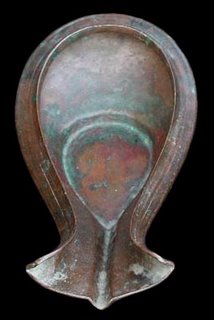shakthi worship & philosophy
The Series:feminism in indian culture
the origins of a tradition
shakthi worship and philosophy
yoni worship
* * *
the sanskrit word shakthi means force, the feminine energy. it is regarded as the primordial creative principle that underlies the cosmos, and as the energising force behind all divinity, creatures and beings.
in several scriptures, the personification of shakthi - kali - was said to be the source of the three aspects in divinity,ie creation, protection and transformation. (for example the niravana tantra narrates how brahma, vishnu and shiva were all born of kali; in the kamanda tantra kali is considered to be brahman personified.)
the ritualistic aspects of shaktha philosophy is marked by the pantheon of female deities, each created to worship a different aspect of feminine power. the breasts, bellies, and yonic* entrances of the goddesses are worshipped and touched reverentially as symbols of the source of all life and the focus of cosmic energy. several vessels are used in worship, signifying the shaping of life, and rebirth. the vessels are also a symbol for the idea that the human body is as a vessel for spiritual transformation.
mainstream hinduism retains traces of shaktha philosophy and rituals as well. even now, the main chambers of temples are built as wombs (garba graha - the womb chamber), the overall structure signifying the yonic passage. (emerging from the chamber thus denotes the "reborn" person.) and all our gods and goddesses have bodies which emphasise their feminine nature - wide hips and thighs and so on.
shiva as natraja with feminine thighs and hips
* yoni - (sanskrit) vagina
Labels: themes





4 Comments:
lol...twas a pretty commonly known idea i thought - glad i gambled and said it anyway if you found it so :) if youre interested, do look up the advaitic symbolism of temple architecture, idols, etc. oh also, look up the lotus - its an absolutely fascinating metaphor for so many wonderfully detailed ideas... brilliant stuff! im firmly telling myself i will NOT bring in religion here, but the advaitic symbols are sooo beautiful! *sigh*
Thought provoking post.
It is intriguing to see that our Godesses in their essentiality, violate the so called "model of a Hindu woman" we are fed today. Our Goddesses were not submissive nor were they subordinated to a male deity, they do not perform "household duties" like a "traditional Hindu woman must do" and they excel at so called "male functions"- like warfare, administration etc etc.
It is good to know that in its essence, the Devi Bhagavatham portrays the Goddess Durga as using her beauty and power not just to Attract the male, but to work independent of the male and attract evil(in male form, finally) so that She can destroy it. Another point for those who might read the DEvi Bhagavatham: The Book repeatedly tells women to come of their subversiveness and be courageous and independent.
I know this is a long comment but this is my way of showing my support to your ideas!
Cheers!
Megha
megha: indeed yes, the goddesses and the heroines were women of much character and strength.
thanks for taking time to voice your thoughts - tis much appreciated!
welcome to the turf :)
Sakthi is an important member of the Hindu pantheon. Sakthi attained the highest in the puranas when she was enlisted in the Trinity along with Vishnu and Siva. In the Vedic literature and epics Sakthi occupied the dominating figure as she became the chief object of worship. Her importance can be seen from the fact that Sakthi was given apposition higher than that of Vishnu and Siva in such purans as the Devi Bhagavatha purana, the Devi puran, the Kalika purana and the Maha Bhagavatha purana. In the sectarian Upanishads, specially the Sakthi Upanishad she is accepted as supreme reality.
Post a Comment
<< Home